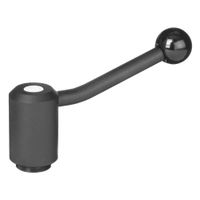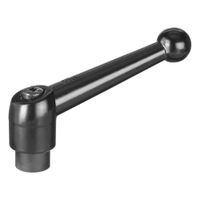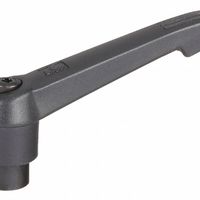Call +(254) 703 030 000 / 751 483 999 / 721 704 777
- Home
- Hardware
- Handles Pulls Knobs
- Machine Handles
- Adjustable Machine Handles
.....Read More
Frequently Asked Questions
What are adjustable machine handles used for?
Adjustable machine handles are used for securing, clamping, and adjusting components on machinery and equipment. They provide a convenient and ergonomic way to apply torque and lock parts in place, ensuring stability and precision in various industrial and mechanical applications. These handles are commonly found in manufacturing, assembly, and maintenance settings, where frequent adjustments are necessary.
The key feature of adjustable machine handles is their ability to reposition without fully disengaging the handle from the component. This is achieved through a ratcheting mechanism or a spring-loaded design that allows the handle to be lifted, repositioned, and then re-engaged at a different angle. This functionality is particularly useful in tight spaces or when the handle's position needs to be changed to avoid obstructions.
Adjustable machine handles are typically used in applications such as:
1. **Machine Tooling**: For securing workpieces or adjusting machine components like jigs, fixtures, and tool holders.
2. **Assembly Lines**: To quickly adjust and lock parts in place during the assembly process.
3. **Maintenance and Repair**: For easy and quick adjustments of machinery components during routine maintenance or repairs.
4. **Packaging Equipment**: To adjust settings on packaging machines for different product sizes or types.
5. **Furniture and Equipment**: In adjustable furniture or equipment where frequent repositioning is required.
These handles are made from durable materials like metal or reinforced plastic to withstand repeated use and provide a secure grip. They come in various sizes and configurations to suit different applications, ensuring versatility and adaptability in diverse industrial environments.
How do teardrop-style adjustable handles prevent slipping?
Teardrop-style adjustable handles prevent slipping primarily through their ergonomic design, which enhances grip and control. The teardrop shape naturally fits the contours of the human hand, providing a more secure and comfortable grip compared to traditional cylindrical handles. This shape increases the surface area in contact with the hand, distributing pressure more evenly and reducing the likelihood of slippage.
The wider end of the teardrop handle acts as a natural stop, preventing the hand from sliding off during use. This is particularly beneficial in situations where the handle might be wet or greasy, as the shape provides a physical barrier against slipping. Additionally, the narrower end allows for a more precise grip, enabling better control and maneuverability.
Many teardrop-style handles are also designed with textured surfaces or made from materials that enhance friction, such as rubber or silicone. These materials increase the coefficient of friction between the hand and the handle, further reducing the risk of slipping. The combination of shape and material ensures that the handle remains secure in the user's hand, even under challenging conditions.
Furthermore, the adjustability of these handles allows users to customize the grip to their specific needs, ensuring optimal comfort and control. By adjusting the handle to the most ergonomic position, users can maintain a natural wrist and hand alignment, reducing fatigue and enhancing grip strength.
Overall, the teardrop-style adjustable handles combine ergonomic design, material choice, and adjustability to effectively prevent slipping, providing a reliable and comfortable user experience.
What is the advantage of ball-style adjustable handles?
Ball-style adjustable handles offer several advantages:
1. **Ergonomic Design**: The rounded shape fits comfortably in the hand, reducing strain and fatigue during use. This ergonomic design is particularly beneficial for tasks requiring repetitive adjustments.
2. **Ease of Use**: The ball shape provides a natural grip, making it easier to apply the necessary torque to tighten or loosen components. This is especially useful in environments where quick adjustments are needed.
3. **Versatility**: These handles are often used in a variety of applications, from machinery and equipment to furniture and fixtures. Their design allows for easy integration into different systems.
4. **Quick Adjustments**: The ball-style handle allows for rapid adjustments without the need for additional tools. This can significantly reduce downtime in industrial settings where efficiency is crucial.
5. **Durability**: Typically made from robust materials like stainless steel or reinforced plastics, ball-style handles are designed to withstand heavy use and harsh conditions, ensuring longevity.
6. **Aesthetic Appeal**: The sleek, rounded design can enhance the visual appeal of equipment or furniture, making them suitable for both functional and decorative purposes.
7. **Safety**: The smooth, rounded edges minimize the risk of injury, making them safer to use in environments where safety is a priority.
8. **Customizability**: Available in various sizes and materials, ball-style handles can be customized to meet specific requirements, offering flexibility in design and application.
9. **Space Efficiency**: Their compact design allows for use in tight spaces where traditional handles might not fit, making them ideal for applications with spatial constraints.
How do adjustable tension levers maintain clamping force?
Adjustable tension levers maintain clamping force through a combination of mechanical design and user-adjustable components. These levers typically consist of a handle, a threaded stud or bolt, and a clamping mechanism. The handle is connected to the stud, which is inserted into a threaded hole or nut on the workpiece or fixture.
The key to maintaining clamping force lies in the lever's ability to adjust the tension applied to the stud. When the lever is rotated, it tightens or loosens the stud within the threaded hole. The lever's design often includes a ratcheting or cam mechanism that allows the handle to be repositioned without altering the tension on the stud. This feature enables the user to achieve the desired clamping force even in tight or awkward spaces where a full rotation of the handle is not possible.
Once the desired tension is achieved, the lever locks into place, ensuring that the clamping force is maintained. The materials used in the construction of the lever, such as high-strength steel or reinforced plastic, contribute to its ability to withstand the forces applied during clamping. Additionally, the design may include features like serrated surfaces or friction-enhancing coatings to prevent slippage and ensure a secure hold.
The adjustability of the tension lever allows for precise control over the clamping force, accommodating variations in workpiece size or material. This adaptability makes adjustable tension levers ideal for applications requiring frequent adjustments or where consistent clamping force is critical. By allowing for easy and repeatable adjustments, these levers ensure reliable performance and maintain the integrity of the clamped assembly.
What materials are adjustable machine handles typically made from?
Adjustable machine handles are typically made from a variety of materials, each chosen for its specific properties that suit different applications. Common materials include:
1. **Steel**: Known for its strength and durability, steel is often used in heavy-duty applications where the handle must withstand significant force and wear. It is usually coated or plated to prevent rust and corrosion.
2. **Stainless Steel**: Offers excellent corrosion resistance, making it ideal for environments exposed to moisture or chemicals. It is also strong and durable, suitable for both indoor and outdoor use.
3. **Aluminum**: Lightweight yet strong, aluminum is used where weight reduction is important. It also provides good corrosion resistance and is often anodized for additional protection and aesthetic appeal.
4. **Plastic**: Various plastics, such as nylon or polypropylene, are used for their lightweight, corrosion resistance, and cost-effectiveness. They are suitable for less demanding applications and are often used in environments where metal might cause damage or contamination.
5. **Zinc Alloy**: Offers a good balance of strength, corrosion resistance, and cost. Zinc alloy handles are often die-cast, allowing for complex shapes and designs.
6. **Brass**: Used for its corrosion resistance and aesthetic appeal, brass is less common but can be found in applications where appearance is important.
7. **Composite Materials**: These are used for specialized applications requiring specific properties, such as high strength-to-weight ratios or resistance to extreme temperatures.
Each material is selected based on factors like the required strength, environmental conditions, weight considerations, and cost. The choice of material impacts the handle's performance, longevity, and suitability for specific industrial or commercial applications.
How do you install adjustable machine handles?
1. **Select the Right Handle**: Choose an adjustable machine handle that fits the specifications of your machine, including thread size and length.
2. **Prepare the Machine**: Ensure the machine is turned off and any moving parts are secured. Clean the area where the handle will be installed to remove any debris or grease.
3. **Remove Existing Handle**: If replacing an old handle, unscrew it by turning counterclockwise. Use a wrench if necessary.
4. **Inspect the Thread**: Check the machine’s threaded hole for damage or debris. Clean or repair as needed to ensure a smooth installation.
5. **Align the Handle**: Position the adjustable handle so that the threaded stud aligns with the machine’s threaded hole.
6. **Screw in the Handle**: Insert the handle’s threaded stud into the hole and turn clockwise. Hand-tighten initially to ensure proper alignment.
7. **Adjust the Handle Position**: Lift the handle to disengage the internal ratchet mechanism, allowing you to reposition the handle without unscrewing it. Rotate the handle to the desired position and release it to re-engage the ratchet.
8. **Tighten Securely**: Once the handle is in the desired position, use a wrench to tighten it securely, ensuring it is firmly attached to the machine.
9. **Test the Handle**: Operate the handle to ensure it moves freely and locks into place as needed. Make any necessary adjustments.
10. **Final Check**: Verify that the handle is securely installed and does not interfere with other machine operations.
11. **Regular Maintenance**: Periodically check the handle for wear and ensure it remains tightly secured. Lubricate if necessary to maintain smooth operation.
What are the common applications for adjustable machine handles?
Adjustable machine handles are versatile components used in various industrial and commercial applications. They are primarily employed for their ergonomic design, which allows for easy adjustment and secure clamping. Common applications include:
1. **Machinery and Equipment**: Used in manufacturing and production environments, adjustable handles facilitate the quick adjustment of machine components, such as levers, knobs, and fixtures, ensuring precise control and positioning.
2. **Workholding Devices**: In CNC machines and lathes, these handles are crucial for securing workpieces. They allow operators to swiftly change and adjust the position of clamps and fixtures, enhancing efficiency and accuracy.
3. **Assembly Lines**: Adjustable handles are used to modify the position of jigs and fixtures, enabling rapid changes in assembly processes. This adaptability is essential for accommodating different product sizes and designs.
4. **Packaging Equipment**: In packaging machinery, these handles help in adjusting the tension and alignment of belts and rollers, ensuring smooth operation and reducing downtime.
5. **Medical Equipment**: Adjustable handles are found in medical devices and equipment, where they allow for the precise positioning of components, such as in surgical tables and diagnostic machines.
6. **Furniture and Ergonomic Products**: In office and industrial furniture, these handles enable the adjustment of chairs, desks, and other ergonomic products, providing comfort and customization for users.
7. **Transportation and Automotive**: Used in vehicles and transport equipment, adjustable handles assist in the adjustment of seats, mirrors, and other components, enhancing user comfort and safety.
8. **Sports and Fitness Equipment**: In gym machines and sports equipment, these handles allow users to adjust resistance levels and positions, catering to different fitness levels and exercise routines.
Overall, adjustable machine handles are integral to operations requiring frequent adjustments, providing convenience, safety, and efficiency across various sectors.


